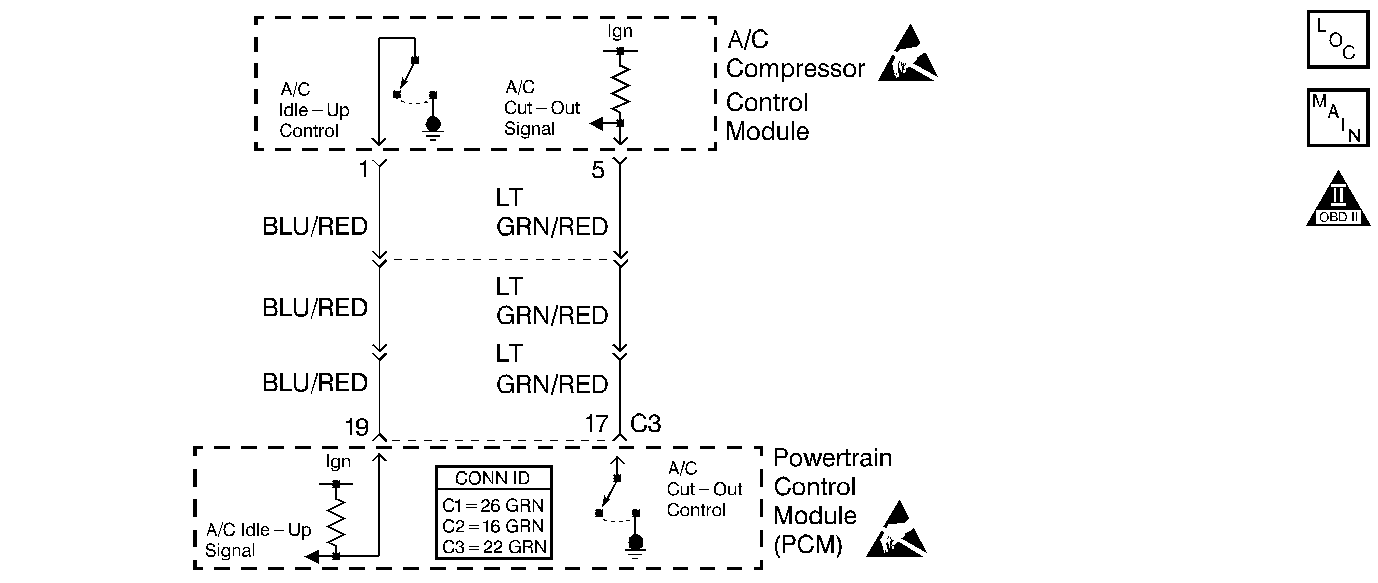
Circuit Description
The A/C compressor control module sends an A/C idle-up signal to the powertrain control module (PCM) when the A/C compressor clutch is ON (engaged). The PCM sends a signal to the idle speed control (ISC) motor in order to command the ISC motor plunger to open the throttle plate. The engine idle speed increases when the throttle plate opens. The increase in the idle speed prevents a rough idle or stalling condition.
Diagnostic Aids
Check for a faulty electrical connection to the PCM.
An intermittent malfunction may be caused by a problem in the A/C idle-up electrical circuit. Inspect the wiring harness and components for any of the following conditions:
| • | Backed out terminals. |
| • | Improper mating of terminals. |
| • | Broken electrical connector locks. |
| • | Improperly formed or damaged terminals. |
| • | Faulty terminal to wire connections. |
| • | Physical damage to the wiring harness. |
| • | A broken wire inside the insulation. |
| • | Corrosion of electrical connections, splices, or terminals. |
If no problem was found in the A/C idle-up circuit check, refer to Symptoms .
Test Description
The numbers below refer to the step numbers in the Diagnostic Table.
-
The Powertrain OBD System Check prompts the technician to complete some basic checks and store the freeze frame data on the scan tool if applicable. This creates an electronic copy of the data taken when the fault occurred. The information is then stored in the scan tool for later reference.
-
This step checks for an increase in the idle speed with the A/C ON.
-
The A/C idle-up signal circuit at the PCM should indicate 0.0 volts with the A/C ON (operating).
-
The A/C idle-up signal circuit at the PCM should indicate B+ with the A/C OFF (not operating).
-
The A/C cut-out signal circuit at the PCM should indicate 0.0 volts with the A/C OFF (not operating).
-
The A/C cut-out signal circuit at the PCM should indicate B+ with the A/C ON (operating).
Step | Action | Value(s) | Yes | No |
|---|---|---|---|---|
Did you perform the Powertrain On-Board Diagnostic System Check? | -- | |||
Does the scan tool indicate ON with the A/C operating? | -- | Go to Diagnostic Aids | ||
Is the voltage at the specified value? | 0 volts | |||
Is the voltage at the specified value? | B+ | |||
5 |
Is the voltage at the specified value? | B+ | ||
6 | Check for an open or a short in the A/C idle up signal circuit between the PCM and the A/C compressor control module. Repair as necessary. Refer to Wiring Repairs in Wiring Systems. Was a repair necessary? | -- | ||
Is the voltage at the specified value? | 0 volts | |||
Is the voltage at the specified value? | B+ | Go to Diagnostic Aids | ||
9 | Check for an open or short to ground in the A/C cut-out signal circuit between the PCM and the A/C compressor control module. Repair as necessary. Refer to Wiring Repairs in Wiring Systems. Was a repair necessary? | -- | ||
10 |
Is the voltage at the specified value? | B+ | ||
11 |
Is the action complete? | -- | -- | |
12 | Replace the PCM. Refer to Powertrain Control Module Replacement . Is the action complete? | -- | -- | |
13 | Operate the vehicle within the conditions under which the original symptom was specified. Does the system now operate properly? | -- | System OK | Go to Diagnostic Aids |
